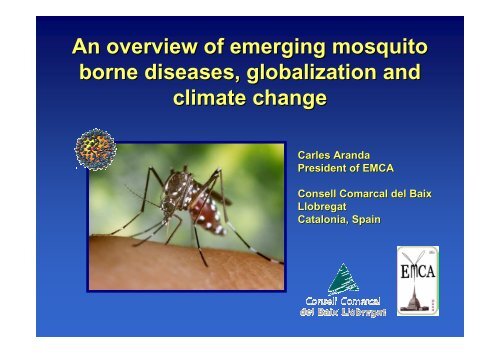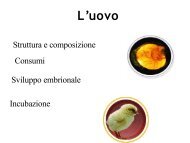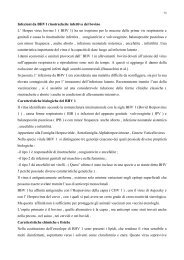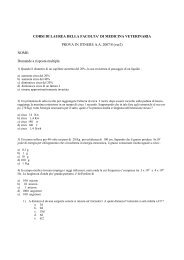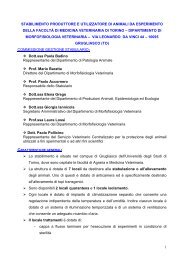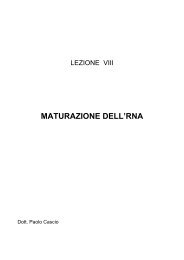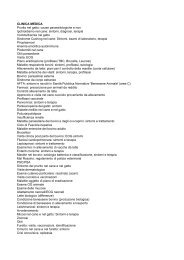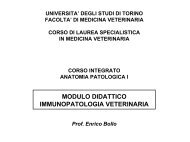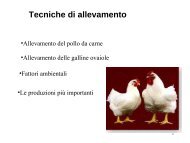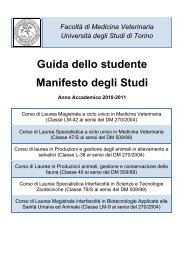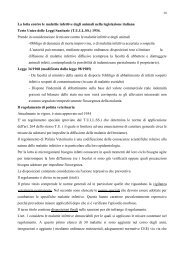An overview of emerging mosquito borne diseases, globalization ...
An overview of emerging mosquito borne diseases, globalization ...
An overview of emerging mosquito borne diseases, globalization ...
You also want an ePaper? Increase the reach of your titles
YUMPU automatically turns print PDFs into web optimized ePapers that Google loves.
<strong>An</strong> <strong>overview</strong> <strong>of</strong> <strong>emerging</strong> <strong>mosquito</strong><br />
<strong>borne</strong> <strong>diseases</strong>, <strong>globalization</strong> and<br />
climate change<br />
Carles Aranda<br />
President <strong>of</strong> EMCA<br />
Consell Comarcal del Baix<br />
Llobregat<br />
Catalonia, Spain
Tarragona 2005
Culicidae as pests and as vectors <strong>of</strong><br />
<strong>diseases</strong><br />
Pests Vectors<br />
Resources<br />
Tourism, quality <strong>of</strong> life<br />
Hemat<strong>of</strong>agous<br />
Health<br />
Diseases
Bulinus sp.<br />
Main vector groups<br />
Snails: Mollusca<br />
Different species<br />
Oncomelania<br />
Biomphalaria<br />
Bulinus<br />
Transmission <strong>of</strong><br />
Schistosoma spp. spp<br />
Schistosomiasis
Triatoma sp.<br />
Main vector groups<br />
Bugs: Triatominae<br />
Different species<br />
Triatoma infestans<br />
Rhodnius prolixus<br />
Transmission <strong>of</strong><br />
Trypanosoma cruzi<br />
Chagas Disease
Ixodes sp.<br />
Main vector groups<br />
Ticks: Ixodida<br />
Different species<br />
Ixodes<br />
Rhipicephalus<br />
Hyalomma<br />
Transmission <strong>of</strong><br />
Rickettsia spp.<br />
Borrelia burgdorferi<br />
Tifus, Lyme
Main vector groups<br />
Fleas: Siphonaptera<br />
Xenopsilla cheopis<br />
Different species<br />
Xenopsilla cheopis<br />
Tunga penetrans<br />
Transmission <strong>of</strong><br />
Yersinia pestis<br />
Plague
Glossina sp.<br />
Main vector groups<br />
Tsetse fleas: Glossinidae<br />
Different species<br />
Glossina<br />
Transmission <strong>of</strong><br />
Trypanosoma gambiense<br />
Trypanosoma rhodesiense<br />
Sleeping sickness or<br />
Trypanosomiasis
Main vector groups<br />
Sandflies: Phlebotominae<br />
Phlebotomus perniciosus<br />
Different species<br />
Phlebotomus<br />
Lutzomyia<br />
Transmission <strong>of</strong><br />
Leishmania spp.<br />
Leishmaniasis
Simulium sp.<br />
Main vector groups<br />
Blackflies: Simuliidae<br />
Different species<br />
Simulium<br />
Transmission <strong>of</strong><br />
Oncocerca volvulus<br />
Oncocerciasis or<br />
Blindness river
Life cycle <strong>of</strong> F. Culicidae:<br />
Culicidinae and <strong>An</strong>ophelinae<br />
Culicidinae<br />
Eggs<br />
<strong>An</strong>ophelinae
Life cycle <strong>of</strong> F. Culicidae:<br />
Culicidinae and <strong>An</strong>ophelinae<br />
Larvae<br />
Culicidinae <strong>An</strong>ophelinae
Life cycle <strong>of</strong> F. Culicidae:<br />
Culicidinae and <strong>An</strong>ophelinae<br />
Pupae<br />
Culicidinae <strong>An</strong>ophelinae
Life cycle <strong>of</strong> F. Culicidae:<br />
Culicidinae and <strong>An</strong>ophelinae<br />
Adults<br />
Culicidinae <strong>An</strong>ophelinae
Life cycle <strong>of</strong> F. Culicidae:<br />
Culicidinae and <strong>An</strong>ophelinae<br />
Female adults<br />
Culicidinae <strong>An</strong>ophelinae
TDR
Main <strong>diseases</strong> transmitted by<br />
Arbovirus<br />
Culicidae<br />
Yellow fever, Dengue, Hemorrhagic Dengue, Chikungunya,<br />
Encephalitis as Saint Louis, Japanese or West Nile<br />
Aedes aegypti, Ae. albopictus, Culex spp.<br />
Filariasis<br />
Lymphatic filariasis: Wuchereria bancr<strong>of</strong>ti, Brugia malayi<br />
Culex spp. <strong>An</strong>opheles spp. spp.<br />
Protozoan<br />
Malaria: Plasmodium falciparum,<br />
falciparum,<br />
P. vivax, vivax,<br />
P. malariae, malariae,<br />
P. ovale<br />
<strong>An</strong>opheles spp. spp.<br />
: <strong>An</strong>. funestus, <strong>An</strong>. arabiensis, <strong>An</strong>. labranchiae
Main aspects that can influence<br />
<strong>mosquito</strong>-<strong>borne</strong> <strong>mosquito</strong> <strong>borne</strong> <strong>diseases</strong><br />
Intrinsic aspects<br />
transmission<br />
• Related to the vector<br />
• Vector competence<br />
• Vector capacity<br />
• Presence <strong>of</strong> the pathogen<br />
• Related to humans<br />
• Presence <strong>of</strong> susceptible humans<br />
• Presence <strong>of</strong> infected humans<br />
New environmental aspects<br />
• Globalization (trade, travels)<br />
• Climate change
Arboviral <strong>diseases</strong>
Typical scheme <strong>of</strong> arbovirus:<br />
Flavivirus<br />
Adapt. from CDC<br />
ar = arthropod<br />
bo = <strong>borne</strong><br />
virus<br />
arbovirus<br />
West Nile Virus
Arboviral <strong>diseases</strong><br />
(Togaviridae: Alphavirus)<br />
Alphavirus)<br />
East Equine Encephalitis (EEE) Culicidae<br />
West Equine Encephalitis (WEE) <br />
Highlands J (HJ)<br />
Venezuelan Equine Encephalitis (VEE) <br />
Chikungunya (CHIK) <br />
O’nyong nyong-nyong nyong (ONN) <br />
Ross River (RR) <br />
Sindbis (SIN) <br />
Semliki Forest (SF) <br />
Barmah Forest (BF)
Arboviral <strong>diseases</strong><br />
(Flaviviridae: Flavivirus) Flavivirus)<br />
Rocio (ROC) Culicidae<br />
Wesselsbron (WSL)<br />
Yellow fever (YF) <br />
Saint Louis Encephalitis (SLE) <br />
Japanese Encephalitis (JE) <br />
Murray Valley Encephalitis (MVE) <br />
West Nile (WN) <br />
Dengue (DEN)
Arboviral <strong>diseases</strong><br />
(Bunyaviridae)<br />
Bunyamwera (BUN). (Bunyavirus<br />
Bunyavirus) ) Culicidae, Ceratopogonidae<br />
Phlebotominae<br />
Cache Valley (CV). (Bunyavirus<br />
Bunyavirus) ) <br />
California Encephalitis (CE). (Bunyavirus<br />
Bunyavirus) ) <br />
Jamestown Canyon (JC). (Bunyavirus<br />
Bunyavirus) ) <br />
LaCrosse (LAC). (Bunyavirus<br />
Bunyavirus) ) <br />
Snowshoe hare (SSH). (Bunyavirus<br />
Bunyavirus) ) <br />
Tahyna (TAH). (Bunyavirus<br />
Bunyavirus) ) <br />
Trivittatus (TVT). (Bunyavirus<br />
Bunyavirus) ) <br />
Oropuche (ORO). (Bunyavirus<br />
Bunyavirus) ) <br />
Rift Valley fever (RVF). (Phlebovirus) <br />
Sand fly fever (SFF). (Phlebovirus)
Arbovirus transmission cycle:<br />
Vector = culicid<br />
Host = different vertebrates<br />
West Nile Virus<br />
Vector<br />
Birds<br />
Humans<br />
Other mammals
WNV in birds<br />
Rapid multiplication <strong>of</strong><br />
the virus<br />
Permanence between<br />
20 and 200 days<br />
Detection <strong>of</strong> WNV in<br />
more than 30 European<br />
species<br />
Climate change can<br />
affect?
WNV in horses and other vertebate<br />
Low virus<br />
multiplication<br />
Permanence between 3<br />
and 6 days<br />
Detection <strong>of</strong> WNV<br />
mainly in horses<br />
although also in<br />
different vertebrates
WNV in humans<br />
Low virus<br />
multiplication<br />
Highest viremia in 4-8 4 8<br />
days<br />
Fever, joint pain,<br />
muscular hache and in<br />
< 15%, encephalitis<br />
and meningitis
WNV in <strong>mosquito</strong>es<br />
Multiplication <strong>of</strong> virus<br />
Permanence during all<br />
life in salivary glands<br />
About 100 species<br />
including genera like:<br />
Culex<br />
Aedes, Ochlerotatus<br />
<strong>An</strong>opheles<br />
Climate change can<br />
affect?
West Nile Virus distribution in<br />
Europe. 1999<br />
Hubálek & Halouzka, 1999<br />
Isolation from<br />
<strong>mosquito</strong>es<br />
or vertebrates<br />
Including<br />
humans<br />
Cases in horses<br />
or humans<br />
<strong>An</strong>tibodies<br />
in vertebrates
Recent West Nile outbreaks in<br />
Europe and Mediterranian Area<br />
Czech R. 1997, 2002, 2007<br />
France<br />
Rumania 1996, 1997, 2001, 2003, 2005-07 2005 07<br />
2000, 2002, 2004, 2006<br />
France 2003, 2007<br />
Italy 1998<br />
Portugal 2004 200<br />
Algeria 1994<br />
Morocco 1996, 2003<br />
Tunisia 1997<br />
Tunisia 2003<br />
Humans<br />
Vertebrate hosts including horses<br />
Israel 1999-2003 1999 2003-2007 2007
West Nile Virus distribution before<br />
1999
West Nile Virus distribution in USA<br />
1999<br />
Presence <strong>of</strong> WNV
West Nile Virus distribution in USA<br />
2000<br />
Presence <strong>of</strong> WNV
West Nile Virus distribution in USA<br />
2001<br />
Presence <strong>of</strong> WNV
West Nile Virus distribution in USA<br />
2002<br />
Presence <strong>of</strong> WNV
West Nile Virus distribution in USA<br />
2003<br />
Presence <strong>of</strong> WNV
West Nile Virus distribution in USA<br />
2004<br />
Presence <strong>of</strong> WNV
Chikungunya in Italy. 2007
Chikungunya in Italy. 2007<br />
Ravenna: Castiglione di Cervia<br />
Castiglione di Ravenna<br />
Between June 15th and September 28th there were more than<br />
200 confirmed cases (about 300 suspected)<br />
First case: traveler from Kerala, India that visited his cousin in<br />
June 23th and got fever July 4th.
European Center for Diseases<br />
Control, ECDC<br />
http://ecdc.europa.eu/Health_topics/Chikungunya_Fever
Present situation in Europe<br />
Chikungunya scenario<br />
•Presence Presence <strong>of</strong> Aedes albopictus<br />
potential vector <strong>of</strong> arbovirus<br />
•Presence Presence <strong>of</strong> Chikungunya<br />
virus (and others)<br />
•Presence Presence <strong>of</strong> susceptible humans<br />
•Presence Presence <strong>of</strong> other potential vectors<br />
Question <strong>of</strong> climate change or <strong>globalization</strong>?
Rift Valley Fever, can it reach<br />
Europe?
Rift Valley Fever, can it reach<br />
Europe?<br />
Phlebovirus (Bunyaviridae) transmitted mainly by <strong>mosquito</strong>es<br />
More than 40 species, including some <strong>of</strong> the most common in<br />
Europe:<br />
Culex pipiens<br />
Aedes vexans<br />
Ochlerotatus caspius<br />
Affects mainly cattle but also humans by <strong>mosquito</strong> bites and<br />
also other ways <strong>of</strong> entrance (fluids and aerosols, etc...)<br />
Originary <strong>of</strong> Africa and detected by first time in Kenya in the Rift Rift<br />
Valley, in 2000 there were some cases in Yemen and Saudi<br />
Arabia.
Rift Valley Fever, can it reach<br />
Europe?<br />
Incubation period in humans <strong>of</strong> 2 to 6 days.<br />
Mainly fever, joint and muscular pain and headache. Sometimes<br />
neck pain, vomiting and photosensibilization.<br />
End <strong>of</strong> simptmas in 7 days.<br />
In few percentages, meningoencephalitis, eye problems and/or<br />
hemorrhagic fever. Lethality about 1%.<br />
Period <strong>of</strong> incubation in animals
Yellow fever and dengue in XVIII<br />
Century in the Spanish empire
Learning from history: yellow fever<br />
and dengue in Europe<br />
Yellow fever<br />
1701 Canary islands, first outbreak<br />
1705 Cadiz<br />
1714 Malaga<br />
1723 Lisbon<br />
1744 Balearic Islands<br />
1700-1800 1700 1800 Spanish and Portuguese coast<br />
1800-1880 1800 1880 Inner parts <strong>of</strong> Iberian Peninsula and other Mediterranean<br />
regions: France, Italy<br />
More than 300,000 deaths in Spain in the first half <strong>of</strong> XIX century century<br />
including 20,000 deaths in Barcelona between 1822-1824 1822 1824
Learning from history: yellow fever<br />
Dengue<br />
and dengue in Europe<br />
1778 Cadiz<br />
<strong>An</strong> outbreak <strong>of</strong> infectious disease called<br />
“La La Piadosa” Piadosa = “Merciful Merciful”<br />
1927 South <strong>of</strong> Spain, <strong>An</strong>dalusia<br />
<strong>An</strong> outbreak <strong>of</strong> “colorado colorado” = “red red” with identical symptoms to actual<br />
dengue,<br />
5% mortality<br />
1883-1886 1883 1886 dengue is present in Greece<br />
1927-1928 1927 1928 Athens and Thessalonica<br />
<strong>An</strong> outbreak <strong>of</strong> dengue with 1 million cases and 1,000 deaths
Learning from history: yellow fever<br />
References<br />
and dengue in Europe<br />
<strong>An</strong>golotti, E. 1980.<br />
La fiebre amarilla. Historia y situación situaci n actual.<br />
La fiebre amarilla en la Barcelona de 1821. Rev. San. Hig. Púb. P b.<br />
54: 89-102. 89 102.<br />
Copanaris, P. 1928.<br />
L’é ’épid pidémie mie de dengue en Grèce Gr ce au cours de l’é l’été<br />
1928. Bull. Off. Intern. Hyg. Pub. 20: 1590- 1590<br />
1601.<br />
Nájera jera <strong>An</strong>gulo, L. 1943.<br />
Los Aedinos españoles espa oles y el peligro de la fiebre amarilla. Graellsia. 1: 29-35. 29 35.<br />
Pittaluga, G. 1928.<br />
El problema de la fiebre amarilla. Medicina de los Países Pa ses Cálidos. C lidos. 5-25. 5 25.<br />
Rico-Avello, Rico Avello, C. 1953.<br />
Fiebre amarilla en España. Espa a. Revista de Sanidad e Higiene Pública. P blica. 1-2: 1 2: 29-87. 29 87.
Learning from history: yellow fever<br />
Lazarettos <strong>of</strong> Maó Ma and<br />
San Simón Sim n in<br />
Spain<br />
and dengue in Europe
Learning from history: yellow fever<br />
and dengue in Europe<br />
Two main events:<br />
Arrival <strong>of</strong> the exotic <strong>mosquito</strong> Aedes aegypti to<br />
Europe (Spain) and continuous introduction<br />
through ships: International trade<br />
Presence <strong>of</strong> yellow fever and dengue viruses in<br />
Ae. aegypti and/or humans<br />
No climatic change !
Learning from history: yellow fever<br />
and dengue in Europe<br />
Ae. aegypti distribution following Rico- Rico<br />
Avelló Avell y Rico, 1953<br />
Aedes aegypti<br />
Distribution<br />
Data since 1899<br />
Common en Spain<br />
until 40’s 40<br />
Latest citation<br />
in 1953
Malaria
Situation <strong>of</strong> malaria in the world<br />
Areas with transmission <strong>of</strong> malaria<br />
Areas with moderate risk<br />
Áreas where malaria dissapearad,<br />
was eradicaed or never existed<br />
Adapt. Eldridge & Edman, 2000
Fertilización del macrogameto<br />
Por el micrigameto<br />
esquizontes<br />
exflagelación del<br />
Microgametocito<br />
gametocitos<br />
eritrocitos<br />
Adapt. Eldridge & Edman, 2000<br />
ooquiste<br />
ooquineto<br />
ERITROCITO<br />
esporozoitos<br />
Glándulas<br />
salivares<br />
hypnozoito<br />
HÍGADO<br />
Tr<strong>of</strong>ozoitos<br />
Malaria cycle<br />
merozoitos<br />
Gametocitos<br />
Esporozoitos<br />
Ooquiste<br />
Esporozoitos<br />
En glándulas salivares<br />
Esporozoitos<br />
Exflagelación<br />
Ooquineto<br />
Fertilización
Vectors <strong>of</strong> malaria in the world<br />
Epidemiologic zone Main vectors<br />
North America<br />
Central America<br />
South America<br />
North Eurasia<br />
Mediterranean<br />
Afro-Arabian<br />
Afro Arabian<br />
Afro-tropical<br />
Afro tropical<br />
Indo-Iranian<br />
Indo Iranian<br />
Indo-Chines<br />
Indo Chines<br />
Malaysian<br />
Chinese<br />
Australasian<br />
<strong>An</strong>. freeborni<br />
<strong>An</strong>. albimanus<br />
<strong>An</strong>. aquasalis<br />
<strong>An</strong>. darlingi<br />
<strong>An</strong>. albimanus<br />
<strong>An</strong>. albitarsus<br />
<strong>An</strong>. darlingi<br />
<strong>An</strong>. atroparvus<br />
<strong>An</strong>. atroparvus<br />
<strong>An</strong>. sacharovi<br />
<strong>An</strong>. superpictus<br />
<strong>An</strong>. culicifacies<br />
<strong>An</strong>. pharoensis<br />
<strong>An</strong>. arabiensis<br />
<strong>An</strong>. funestus<br />
<strong>An</strong>. gambiae<br />
<strong>An</strong>. culicifacies<br />
<strong>An</strong>. fluviatilis<br />
<strong>An</strong>. culicifacies<br />
<strong>An</strong>. dirus<br />
<strong>An</strong>. balabacensis<br />
<strong>An</strong>. dirus<br />
<strong>An</strong>. minimus<br />
<strong>An</strong>. sinensis<br />
<strong>An</strong>. farauti<br />
<strong>An</strong>. punctulatus
Factors affecting malaria<br />
transmission<br />
• Specific knowledge <strong>of</strong> vectors<br />
• Behavior <strong>of</strong> vectors in the studied area<br />
• Knowledge <strong>of</strong> ecosystem<br />
• Interactions between humans, vectors and<br />
ecosystem
Specific knowledge<br />
<strong>An</strong>opheles arabiensis
PCR for <strong>An</strong>. Gambiae complex
Exophagy<br />
<strong>An</strong>tropophily<br />
Behaviour <strong>of</strong> vectors<br />
Exophily<br />
Endophagy<br />
Endophily<br />
Zoophily
Knowledge <strong>of</strong> ecosystem
Interactions
Main factors for the reintroduction<br />
<strong>of</strong> malaria<br />
Increase <strong>of</strong> parasite carriers by<br />
immigration or travel (Globalization)<br />
Climate change<br />
Presence <strong>of</strong> potential vectors<br />
Sensibility <strong>of</strong> <strong>An</strong>opheline to different<br />
Plasmodium species and strains<br />
Important deterioration <strong>of</strong> health<br />
services and economic situation
Imported malaria in Spain and<br />
European Union. 1972 – 2007<br />
1.000<br />
900<br />
800<br />
700<br />
600<br />
500<br />
400<br />
300<br />
200<br />
100<br />
0<br />
BES, WHO http://data.euro.who.int/cisid<br />
72 74 76 78 80 82 84 86 88 90 92 94 96 98 00 02 04 06<br />
E<br />
Spain EU<br />
EU<br />
14.000<br />
12.000<br />
10.000<br />
8.000<br />
6.000<br />
4.000<br />
2.000<br />
0
Imported malaria in Spain and<br />
European Union. 2007<br />
WHO http://data.euro.who.int/cisid<br />
5000<br />
4500<br />
4000<br />
3500<br />
3000<br />
2500<br />
2000<br />
1500<br />
1000<br />
500<br />
0<br />
Austria<br />
Portugal<br />
Ireland<br />
Denmark<br />
Sweden<br />
Belgium<br />
Netherlands<br />
Spain<br />
Germany<br />
Italy<br />
UK<br />
France
Portugal. 1973-1976. 1973 1976. Independence <strong>of</strong><br />
<strong>An</strong>gola, Mozambique and Timor<br />
1973-1974:<br />
1973 1974: Arrival <strong>of</strong> 253,746 soldiers<br />
1975-1976:<br />
1975 1976: Arrival <strong>of</strong> 900,000 people<br />
80% P. falciparum,<br />
falciparum,<br />
P. vivax carriers<br />
Exposed to <strong>An</strong>. atroparvus bites<br />
Only one detected non imported malaria case<br />
Cambournac, 1977
Not imported malaria, possibly<br />
autochthonous in EU<br />
Country Cases Species Reference<br />
Italy, 97 Baldari et al., 98<br />
1 P. vivax<br />
Greece, 99, 00 1, 2 ? WHO, 06<br />
Spain, 01 1 P. ovale Cuadros et al., 02
Europe
Europe, WHO<br />
WHO http://data.euro.who.int/cisid
Countries included in Europe. WHO
Autochthonous malaria in WHO<br />
European region. 2002<br />
WHO http://data.euro.who.int/cisid
Autochthonous malaria in WHO<br />
European region. 1971 – 2007<br />
WHO http://data.euro.who.int/cisid
Main factors for the reintroduction<br />
<strong>of</strong> malaria<br />
Increase <strong>of</strong> parasite carriers by<br />
immigration or travel<br />
Climate change<br />
Presence <strong>of</strong> potential vectors<br />
Sensibility <strong>of</strong> <strong>An</strong>opheline to different<br />
Plasmodium species and strains<br />
Important deterioration <strong>of</strong> health<br />
services and economic situation
1,2<br />
1<br />
0,8<br />
0,6<br />
0,4<br />
0,2<br />
Climatic change and malaria<br />
0<br />
13 15 17 19 21 23 25 27 29 31 33 35 37 39<br />
Ep = 1/k{-log( 1/ log(p)/ )/a2pn }<br />
Mod. <strong>of</strong> Martens et al. 1995
Main factors for the reintroduction<br />
<strong>of</strong> malaria<br />
Increase <strong>of</strong> parasite carriers by<br />
immigration or travel<br />
Climate change<br />
Presence <strong>of</strong> potential vectors<br />
Sensibility <strong>of</strong> <strong>An</strong>opheline to different<br />
Plasmodium species and strains<br />
Important deterioration <strong>of</strong> health<br />
services and economic situation
Rice field areas in Spain by<br />
provinces. 2005<br />
Total ha: 117,026<br />
Provinces with rice fields
Main factors for the reintroduction<br />
<strong>of</strong> malaria<br />
Increase <strong>of</strong> parasite carriers by<br />
immigration or travel<br />
Climate change<br />
Presence <strong>of</strong> potential vectors<br />
Sensibility <strong>of</strong> <strong>An</strong>opheline to different<br />
Plasmodium species and strains<br />
Important deterioration <strong>of</strong> health<br />
services and economic situation
Sensibility <strong>of</strong> <strong>An</strong>. maculipennis s.l<br />
for Plasmodium genus<br />
Mosq. Plasmod. Ooq. Sporo. Mosq. Plasmod. Ooq. Sporo.<br />
origin origin + + origin origin + +<br />
P. falciparum P. vivax<br />
<strong>An</strong>. atroparvus UK India 0/109 ----- <strong>An</strong>. atroparvus USSR Laos 66/273 20/134<br />
<strong>An</strong>. atroparvus UK West Africa 0/310 ----- <strong>An</strong>.atroparvus USSR Nigeria 4/33 3/41<br />
<strong>An</strong>. atroparvus Italy Kenya 2/48 0/15 <strong>An</strong>. atroparvus USSR India 5/38 1/8<br />
<strong>An</strong>. atroparvus Italy Kenya 0/69 0/41 <strong>An</strong>. atroparvus USSR Pakistan 3/43 2/40<br />
<strong>An</strong>. atroparvus USSR Mali 0/214 0/246 <strong>An</strong>. atroparvus USSR Yemen 53/212 41/275<br />
<strong>An</strong>. atroparvus USSR Guinea 0/38 0/29 <strong>An</strong>. atroparvus USSR Brazil 15/98 7/48<br />
<strong>An</strong>. atroparvus USSR Costa Marfl 0/33 0/22<br />
<strong>An</strong>. atroparvus USSR H. Volta 0/86 0/60 P. malariae<br />
<strong>An</strong>. atroparvus USSR Somalia 0/65 0/38<br />
<strong>An</strong>. atroparvus USSR Togo 0/37 0/24 <strong>An</strong>. atroparvus USSR Laos 0/10 ----<br />
<strong>An</strong>. Atroparvus USSR Zambia 0/33 0/35 <strong>An</strong>. atroparvus Rum. Nigeria 29/283 ----<br />
<strong>An</strong>. atroparvus USSR Guinea Ec. 0/107 0/114 <strong>An</strong>. atroparvus UK Nigeria 5/72 18/45<br />
<strong>An</strong>. atroparvus USSR India 0/45 0/44<br />
<strong>An</strong>. atroparvus USSR Pakistan 0/49 0/31 P. ovale<br />
<strong>An</strong>. subalpinus USSR R. Centroafr. ----- 1/4<br />
<strong>An</strong>. atroparvus Port. East Africa ----- 0 <strong>An</strong>. atroparvus USSR Guinea 0/41 0/50<br />
<strong>An</strong>. atroparvus UK ¿? 1/43 0/43 <strong>An</strong>. atroparvus USSR Mali 0/27 0/24<br />
<strong>An</strong>. atroparvus Spain ¿? 0/57 0/57 <strong>An</strong>. atroparvus USSR Tanzania 0/31 0/32<br />
<strong>An</strong>. atroparvus USSR Mozambique 0/29 0/16<br />
<strong>An</strong>. atroparvus USSR Centroafr. Rep. 0/68 0/27<br />
Shute, Ramsdale &Coluzzi, Daskova & Rasnicyn, Ribeiro<br />
et al., Marchant et al., Gemert & Hoogh<strong>of</strong>. Different years
Main factors for the reintroduction<br />
<strong>of</strong> malaria<br />
Increase <strong>of</strong> parasite carriers by<br />
immigration or travel<br />
Climate change<br />
Presence <strong>of</strong> potential vectors<br />
Sensibility <strong>of</strong> <strong>An</strong>opheline to different<br />
Plasmodium species and strains<br />
Important deterioration <strong>of</strong> health<br />
services and economic situation
Important loss <strong>of</strong> economic and<br />
sanitary conditions<br />
Tajikistan
Basic reproductive rate R 0<br />
MacDonald, 1957<br />
R0 0 = (ma (m 2 Pn / -ln ln P) b c 1/r<br />
If R0 >1, will be more cases after the first one<br />
m Vector density to humans<br />
a Proportion <strong>of</strong> vectors feeding in humans (bites per human,<br />
<strong>mosquito</strong>, day)<br />
b Efficiency <strong>of</strong> transmission from an infected <strong>mosquito</strong> to a human<br />
c Efficiency <strong>of</strong> transmission from an infected human to a <strong>mosquito</strong><br />
P daily survival rate <strong>of</strong> the vector<br />
n Extrinsic period <strong>of</strong> incubation <strong>of</strong> the virus (EIP) in days<br />
1/r Human infectious period (in days)
Some remarks or conclusions<br />
There is a constant entrance and increase <strong>of</strong> pathogen carriers<br />
in Europe and all around the world.<br />
Increase <strong>of</strong> temperature in geographic areas such as Europe may have have<br />
an incidence in the potential transmission <strong>of</strong> <strong>diseases</strong>.<br />
Increase <strong>of</strong> temperature may increase extension <strong>of</strong> vectors distribution distribution<br />
but, there are other factors that can act in an opposite way.<br />
Mosquito vectors are well distributed and in contact with humans. humans<br />
Sensibility <strong>of</strong> European vectors to different pathogens is variable variable<br />
according species and pathogens but it is not neglectable.<br />
Introduction <strong>of</strong> more exotic vectors seems to be difficult but possible possible<br />
depending on diverse factors like climate and apropiate habitats. habitats<br />
Socioeconomic conditions are important factors that can influence influence<br />
dramatically outbreaks, especially in <strong>diseases</strong> such as malaria.
Photography:<br />
C. Aranda, H. H. Arentsen, M.M. Cutwa, R. Eritja, J. Gathany (CDC), (CDC),<br />
R. Khun, E. Marquès, Marqu s, L. Munsterman, R. Torres


